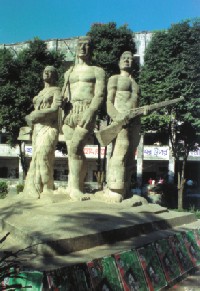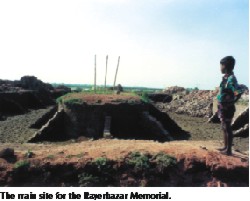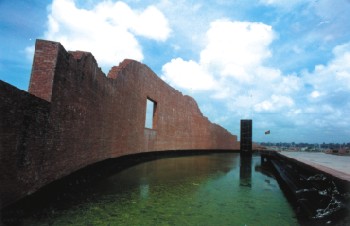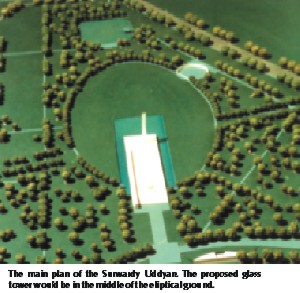|
Icons
of History
Mustafa
Zaman
Memorials
are signs in the shape of architectural structures or
sculptures. They rekindle our spirit that we once invested
in actions, actions that made history and later translated
into deferential forms or structures.
In Bangladesh the Shahid Minar that was erected to commemorate
the martyrs of Language Movement set off the culture
of building monuments. Later, after the seminal victory
in 1971, structures dedicated to the history of independence
were built. Though years have elapsed since the completion
of these national monuments they aptly define our cultural
and historical heritage.
But there is another hidden element behind these glorious
structures. There are many untold stories of the artists
who turned their visions into such tangible forms. The
architects behind the main monuments that depict our
struggle for freedom give a rare insight into the thoughts
behind their creation, their moments of frustration
and elation during envisioning or planning these remarkable
labours of love.
 Savar
Smritishowdha Savar
Smritishowdha
Syed
Mainul Hossain, the architect of the National Monument,
used to work as consultant in a firm in 1978 when an
open competition for the design for the national monument
at Savar was announced. “There were two competitions
all together. The juries were not satisfied with the
submissions first time around. So, there was a second
competition and it was on this occasion that my design
was given the first prize,” remembers Hossain.
Hossain
was not satisfied with his first attempt. “I had this
idea of two columns being compressed to meet at the
top to evoke a feeling of upward thrust,” says Hossain.
It
was the second time that his effort found proper expression.
He was a man engrossed in the daily grind of his office
duties. Yet he found time to build his dream project
in a small-scale. “I built a 64/1 model, and used to
keep looking at it while lying in bed to get the feel
of the real structure seen from its base,” recalls Hossain.
He later built a larger prefabricated model that he
submitted for the competition.
His
friend, Badrul Haider, a working architect, remembers
how Mainul Hossain came to his place with all the separated
components of his model in his hands on the submission
day. “When he assembled them on a table I was sure that
this was the winning entry, ours were nowhere near his,”
recalls Badrul.
Seven
pointed L-shaped concrete structures with variable heights
and widths are sequentially placed to look like a huge
153 feet high pointed triangle that seems splayed out
at the base from the front. Built in the middle of a
spread of an 84-acre area, designed by the architect
and a freedom fighter Abdur Rashid, it includes everything
from the original mass grave and the early bhittiprastar
(foundation stone) to helipads, a parking lot, a stretch
of wall for mural and areas of gardens. It is lined
with a buffer zone to separate the marked zone from
the rest of Savar.
From
its entrance to the monument, one has to walk a straight
passage divided into four plazas. The plan for the area
was finalised right after independence, though it was
during the early years of the autocratic regime of Ershad
that the project was hurriedly completed compromising
durability and the original plan.
The
main structure that Hossain designed in 1978 won the
first prize. It was completed within three months. By
the end of 1982 the structure stood tall, though cracks
were visible in many of the structures.
Hossain
remembers how he felt climbing up the 150 ft high bamboo
scaffolding, “It was an experience to see the Savar
in its entirety from that height, I was lured to go
up and scan the horizon,” Hossain says recalling his
days as a consultant who periodically visited the sight.
The architect, who was later decorated
with Ekushey Padak and IAB honour, had to witness his
design being materialised so hastily that it was born
with faults. “The cracks that run through the structures
are the result of lack of experience on the part of
the builder and the span of time it was given,” contends
Hossain who was for cutting down of costs by sticking
to the idea of building thinner structures.
Seven harmonious structures correspond
to 52, the year of the Language Movement, the dates
of freedom and independence days, respectively 16 and
26. “When the two digits are added of each of the figure,
you get the number 7. This spurred me to go for seven
structures,” reveals Hossain, an architect who has given
this nation one of its original structures.
 Aparajeyo
Bangla Aparajeyo
Bangla
“There are monuments recognised and
built by the government, and there are monuments that
are build by the people, mine is of the second kind,”
argues Syed Abdullah Khalid, the sculptor who built
the first national monument. The idea of sculpture as
a monument was not new in Bangladesh. Hamidur Rahman
and Novera Ahmed set the precedent by building a structured
sculpture in memory of the martyrs of the Language Movement.
Aparajeyo Bangla is the reflection of
the student movements that helped shape a political
culture of dissent that culminated into movements and
lastly resulted in the freedom struggle. “This sculpture
is a reflection of our collective consciousness and
political milieu that it gave birth to, the general
students had a strong bearing on that,” says the artist
who was a young teacher at the Department of Fine Arts
at the Chittagong University in 1973 when the project
was launched.
The Dhaka University Students' Union,
DCSU and the authority joined hands to give the spirit
of liberation a physical and symbolic shape.
“The model for the work was built within
three months starting from January of 1973,” Khalid
remembers. The then Vice Chancellor of the university
came to see and “was taken by its expressive quality”.
When he came to know that it would cost Taka 50 thousand
to build, he gave the go ahead. Though later DUCSU had
to play a role in providing the fund. The sculpture
now stands at 17 and half feet in concrete structure,
including the height of the base.
Work started amidst opposition from
the so-called pro-Islamic fronts. “Making of the sculpture
was another movement all together, I had to campaign
for it. DCSU and the pro-liberation forces had to fight
for it,” remembers Khalid. Yet on the day of the murder
of Bangabandhu on 15 August 1975, work came to a halt.
Khalid recalls how resuming its construction
was another war. Disappointed and demoralised, the artist
left for England where he was to receive a diploma in
metal casting. This was in 1977, at the end of this
year he was informed that the work of the sculpture
would restart.
In
December, he was in Dhaka to give impetus to the signature
campaign of the general students. By then Anwar Jahan's
sculpture, which was awaiting the work of curing after
casting was done, was uprooted one night. “
That same pro-Islamic element made attempts to break
the unfinished Aparajeyo Bangla,” recalls the artist
who thinks that the monuments are expressions of a collective
mind. “They are the structures where mind and matter
come together,” he adds.
At the end of December, 1978, the work
resumed. It took another whole year to finish. It was
inaugurated in a DUCSU-organised ceremony on 16 December
1979 by 12 freedom fighters who came in wheel chairs
to unveil a structure that now upholds both the history
of independence and its making.
 The
Rayerbazar Badhabhumi Smritishoudha The
Rayerbazar Badhabhumi Smritishoudha
Built by two friends Farid Uddin Ahmed
and Md. Jami Al Shafi, the Rayerbazar Memorial is a
belated homage to the intellectual martyrs. It was completed
in 1999 and was opened on 14 December on that year.
Alongside the sporadic killing that took place, at the
last moment of the war, when there was only two days
left to the surrender of the Pakistan force, the collaborators,
the deshi quislings gave the wholesale killing by the
army a final and freaky touch. They implemented their
master plan to wipe out the intellectuals who had the
courage to stand against them while not leaving the
country.
The two young architects were faced
with the problem of bringing into view the solemnity
befitting the martyred intellectuals. It was in 1993
that the competition was held, and the two fresh graduates
from the Department of Architecture, BUET bagged the
first prize.
“Couple of days before the submission,
when our main model was complete, and we were giving
it the additional touches, two little kids of our landlord
came in and spontaneously uttered, 'Bhaiya this model
does not look good, it makes you sad',” remembers Shafi.
For he and his partner the response of these children
was a reassurance of the mournful feeling the small-scale
structure emanated.
Shafi
also remembers how frustrating it was to see their project
being put off for years. Out of 22 participants, their
model was declared first by the jury, yet it was not
until 1996 that the foundation stone was put up. “We
were not sure then that this project would be implemented,
as we had seen many other ventures stalled to the point
of not being built,” says Shafi recalling how unsure
he felt back than.
 At
present, the project that altered their standing among
the peers are in utter neglect. Maintained by the Public
Works Department (PWD), it bears no sign of being looked
after. The granite pillar, one of its main components,
is already losing its stones. As a monument, its unique
feature lies in the uneven construction of a curved
wall with a big squire punch on it that replaces the
traditional idea of a symmetrical obelisk. At
present, the project that altered their standing among
the peers are in utter neglect. Maintained by the Public
Works Department (PWD), it bears no sign of being looked
after. The granite pillar, one of its main components,
is already losing its stones. As a monument, its unique
feature lies in the uneven construction of a curved
wall with a big squire punch on it that replaces the
traditional idea of a symmetrical obelisk.
“During its construction relatives of
the martyrs used to visit the site, some used to recite
the Koran, some came to pass time in silence,” recalls
Shafi. Ahmed says that they all loved what they saw.
“It is a strong existence, and it is out of reach,”
says Ahmed. Flanked by a body of water, the curved break
wall gives the feeling of incompleteness. “Both soft
and hard materials converge to make the smritishowdha
complete,” Shafi reflects. A water body, especially
made bricks, grass, the plaza or the podium in layman
terms, and carefully planted trees, of which the most
significant of them is the banyan tree included at one
side of the foreground, are the elements that come together
here at Rayerbazar. The banyan stands as a reminder
of the old banyan that was the last post of Dhaka, past
that the low lands began. The original one still stands
many yards away. Though unattended, it is the tree up
to which the martyrs were brought in blindfolded by
car and then from that point on were led to the low
land to face their terrible fate.
The
Shadhinata Stambha
One of the recent cases of dithering
with a project that has to do with the history of independence
is the installation at the Suhrwardy Uddyan. It was
a huge project that was taken up by the Awami league
government back in 1997. It had its share of the usual
flak from the opposition, as they saw it as a partisan
venture.
 The
Urbana, run by young architects like Kashef Mahboob
Chowdhury and Marina Tabassum, with other colleagues
working with them at the time, were the ones who envisaged
a glass tower that won over the then head of the government.
The tall glass tower proposed by the firm Urbana was
hinged around an equally large expenditure. Sixty-seven
crore Taks was the proposed amount for the glass tower
alone, and the another hefty 82 crore was estimated
for the underground museum and the plaza upon which
the main tower would stand. “There is no national archive
or museum to preserve the history of independence. We
elaborately planned this underground museum to fill
out that gap,” reflects Kashef who thinks the National
Museum does not have adequate space or exhibits dedicated
to the war of independence. The
Urbana, run by young architects like Kashef Mahboob
Chowdhury and Marina Tabassum, with other colleagues
working with them at the time, were the ones who envisaged
a glass tower that won over the then head of the government.
The tall glass tower proposed by the firm Urbana was
hinged around an equally large expenditure. Sixty-seven
crore Taks was the proposed amount for the glass tower
alone, and the another hefty 82 crore was estimated
for the underground museum and the plaza upon which
the main tower would stand. “There is no national archive
or museum to preserve the history of independence. We
elaborately planned this underground museum to fill
out that gap,” reflects Kashef who thinks the National
Museum does not have adequate space or exhibits dedicated
to the war of independence.
The
design of the plaza is a rectangle upon which the Shikha
Chirantan, the 7 feet high triangular installation in
commemoration of the 7 March address of Banga-bandhu,
a long, continuous wall along the left side, a shallow
round pool at the middle with a hole that slowly sucks
away the water and lastly at the end the huge glass
tower is placed.
The
controversy that surrounds the monument in best part
was concerned with the felling of trees. Although as
a city park, the Uddyan was never designed according
to standard norms. It was a huge open field in the 60s,
and later in the eighties became home to unplanned vegetation
and sporadic clustered areas of trees.
Kashef
and his colleagues proposed a gradual transformation
of this park, which is one of last few outposts of greenery
in this city. They also had a plan to produce in the
middle of the park an elliptical clearing. On the fringe
of the clearing a sunken amphitheatre designed.
Out
of forty-four firms participating Kashef and Marina's
was the winning design. At present, rumours abound regarding
its fate. Some are buying that the present government
is planning to include sculpture of the late president
Zia. “This is all hearsay. It is our design and we did
not try to put our signature in it, we fashioned it
in way a national monument ought to be,” contends Kashef.
The
project now is left to deteriorate in its incomplete
state. Work came to a halt on the night of the last
parliament election. “We planned a living tower. The
look of it changes during the day and at night it is
lit from within it and is the major source of light
in this huge area. Any change to that idea would undermine
the significance of the project,” believes Kashef.
The
Mujib Nagar Sritishowdha
 The
plan for Mujib Nagar Smritishowdha at Mherpur was formulated
right after independence. But the real work began as
late as the early eighties. It was in 1984 that the
designs were called from architects and artists. Diagram
Architects, run by three young architects-- Saiful Haque,
Jalal Ahmed and Khaled Noman, won the first prize for
their unusual design structured in grid pattern. The
plan for Mujib Nagar Smritishowdha at Mherpur was formulated
right after independence. But the real work began as
late as the early eighties. It was in 1984 that the
designs were called from architects and artists. Diagram
Architects, run by three young architects-- Saiful Haque,
Jalal Ahmed and Khaled Noman, won the first prize for
their unusual design structured in grid pattern.
Though
the sprawled-out design of the three architects made
an impression in the minds of the juries, which resulted
in their winning of the first prize, the then autocrat
H.M. Ershad arbitrarily ordered government architects
to come up with a design that was later built.
The
multiple sun-dials that now exist is the one built by
the Department of Archtecture, Ministry of Work. The
architects were Shah Alam, Md. Tanweer, Tanweer Karim
and A.S.M. Ismail.
“Winning
a competition then gave us a moral boost, but it was
frustrating to see that a prize-winning structure was
side-stepped to make way for another design” says Haque,
who now runs his own firm at Dhanmondi.
The
concept of the original design sprang from a photograph,
where Nazrul Islam, the then acting President of the
newly declared country, and other prominent leaders
and the attending crowd that included the villagers
that came from near and far. “We kept the scale human,
as our idea was to express the sense of fraternity that
was the essence of 17 April, 1997, when the interim
government was formed at Mujib Nagar,” Haque informs.
The original design was an installation that took into
account the existing environ. Its build was an expression
that puts the idea of vertical monuments on its head.
Photo
by Zahedul I Khan, Syed Zakir Hossain
and Diagram Architects |

 Savar
Smritishowdha
Savar
Smritishowdha Aparajeyo
Bangla
Aparajeyo
Bangla  The
Rayerbazar Badhabhumi Smritishoudha
The
Rayerbazar Badhabhumi Smritishoudha At
present, the project that altered their standing among
the peers are in utter neglect. Maintained by the Public
Works Department (PWD), it bears no sign of being looked
after. The granite pillar, one of its main components,
is already losing its stones. As a monument, its unique
feature lies in the uneven construction of a curved
wall with a big squire punch on it that replaces the
traditional idea of a symmetrical obelisk.
At
present, the project that altered their standing among
the peers are in utter neglect. Maintained by the Public
Works Department (PWD), it bears no sign of being looked
after. The granite pillar, one of its main components,
is already losing its stones. As a monument, its unique
feature lies in the uneven construction of a curved
wall with a big squire punch on it that replaces the
traditional idea of a symmetrical obelisk. The
Urbana, run by young architects like Kashef Mahboob
Chowdhury and Marina Tabassum, with other colleagues
working with them at the time, were the ones who envisaged
a glass tower that won over the then head of the government.
The tall glass tower proposed by the firm Urbana was
hinged around an equally large expenditure. Sixty-seven
crore Taks was the proposed amount for the glass tower
alone, and the another hefty 82 crore was estimated
for the underground museum and the plaza upon which
the main tower would stand. “There is no national archive
or museum to preserve the history of independence. We
elaborately planned this underground museum to fill
out that gap,” reflects Kashef who thinks the National
Museum does not have adequate space or exhibits dedicated
to the war of independence.
The
Urbana, run by young architects like Kashef Mahboob
Chowdhury and Marina Tabassum, with other colleagues
working with them at the time, were the ones who envisaged
a glass tower that won over the then head of the government.
The tall glass tower proposed by the firm Urbana was
hinged around an equally large expenditure. Sixty-seven
crore Taks was the proposed amount for the glass tower
alone, and the another hefty 82 crore was estimated
for the underground museum and the plaza upon which
the main tower would stand. “There is no national archive
or museum to preserve the history of independence. We
elaborately planned this underground museum to fill
out that gap,” reflects Kashef who thinks the National
Museum does not have adequate space or exhibits dedicated
to the war of independence. The
plan for Mujib Nagar Smritishowdha at Mherpur was formulated
right after independence. But the real work began as
late as the early eighties. It was in 1984 that the
designs were called from architects and artists. Diagram
Architects, run by three young architects-- Saiful Haque,
Jalal Ahmed and Khaled Noman, won the first prize for
their unusual design structured in grid pattern.
The
plan for Mujib Nagar Smritishowdha at Mherpur was formulated
right after independence. But the real work began as
late as the early eighties. It was in 1984 that the
designs were called from architects and artists. Diagram
Architects, run by three young architects-- Saiful Haque,
Jalal Ahmed and Khaled Noman, won the first prize for
their unusual design structured in grid pattern.